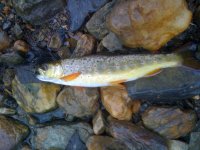sunra
Member
- Joined
- Jun 18, 2007
- Messages
- 41
Let me apologize for posting a topic which I am sure is covered in here somewhere....
I am curious as to how to detect the drift of my nymphs without an indicator of some sort. Even more frustrating to me are the problems created by using the various types of drift indicators.
My feeling is that, when using a long leader and tippet, there is so much distance from the end of the fly line that unless I can see the leader in the water I cannot detect subtle takes.
Unfortunately, I find the different types of indicators either don't ride high enough for me to see or they get wet and sink.
Also, the dry dropper setup, while appealing to me seems not to work too well if I am getting that dropper down on the bottom, i.e. with tungsgten, etc. ALSO, I am wondering whether I should just use a long piece of tippet of heavier gauge to attach the dropper. Might this make casting/turning over the nymph less likely to form a bird's nest??
I apperciate any thoughts on this.
I am curious as to how to detect the drift of my nymphs without an indicator of some sort. Even more frustrating to me are the problems created by using the various types of drift indicators.
My feeling is that, when using a long leader and tippet, there is so much distance from the end of the fly line that unless I can see the leader in the water I cannot detect subtle takes.
Unfortunately, I find the different types of indicators either don't ride high enough for me to see or they get wet and sink.
Also, the dry dropper setup, while appealing to me seems not to work too well if I am getting that dropper down on the bottom, i.e. with tungsgten, etc. ALSO, I am wondering whether I should just use a long piece of tippet of heavier gauge to attach the dropper. Might this make casting/turning over the nymph less likely to form a bird's nest??
I apperciate any thoughts on this.




